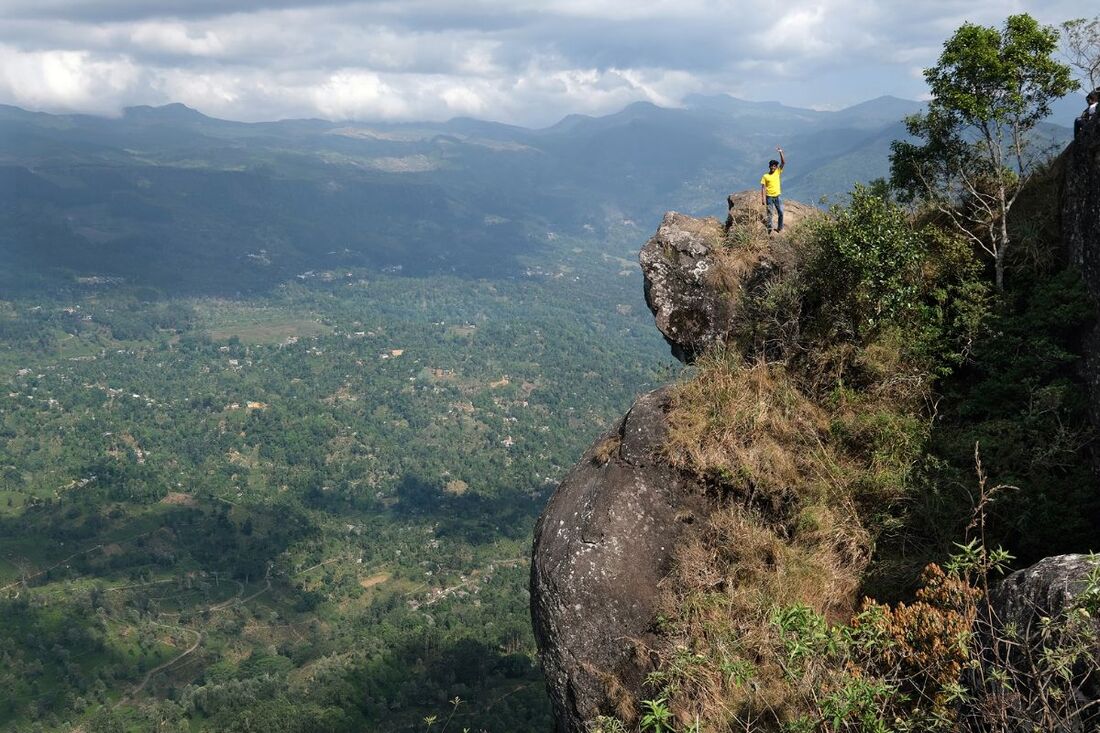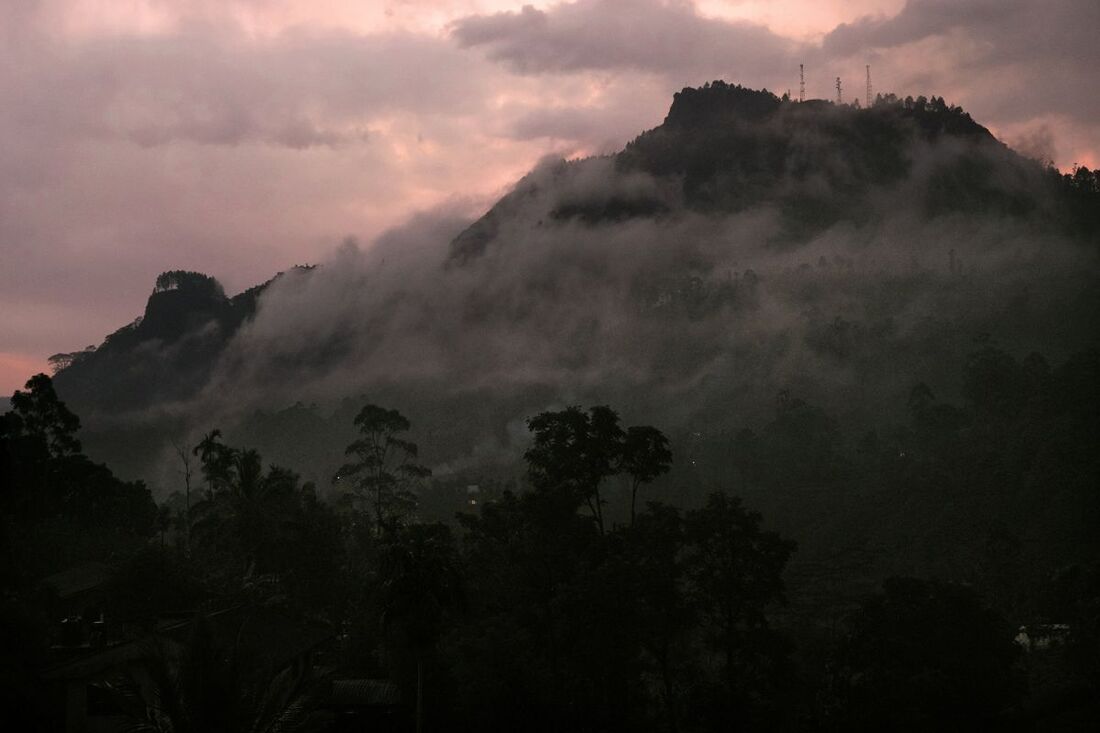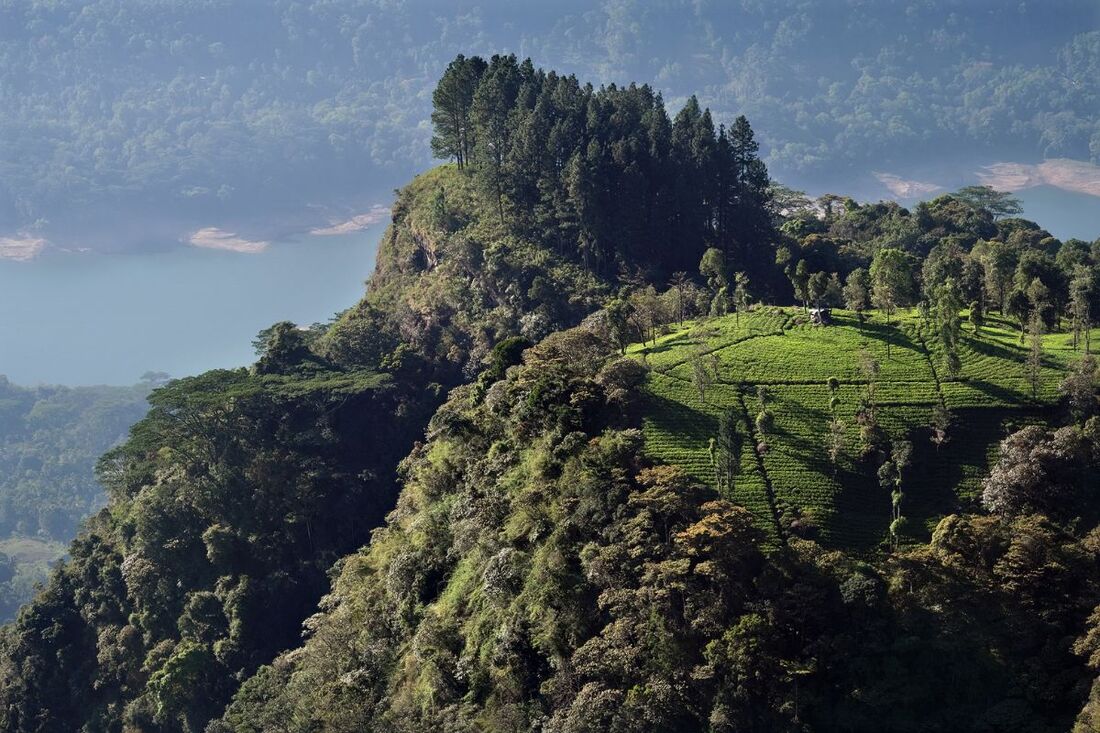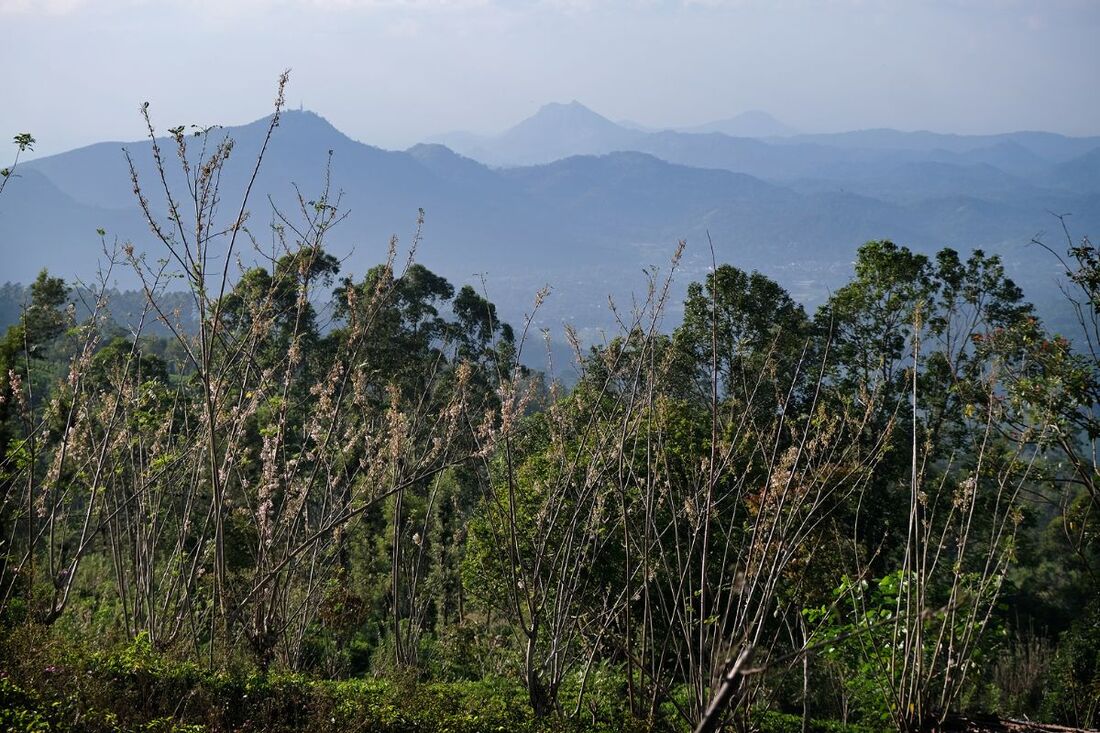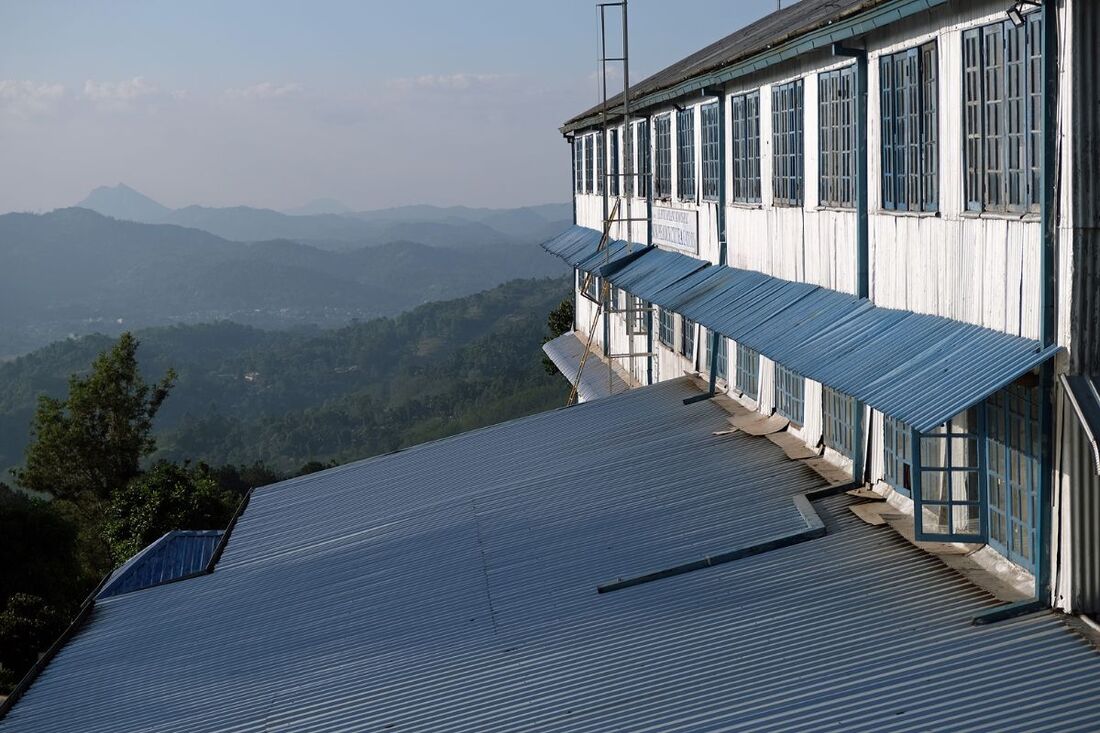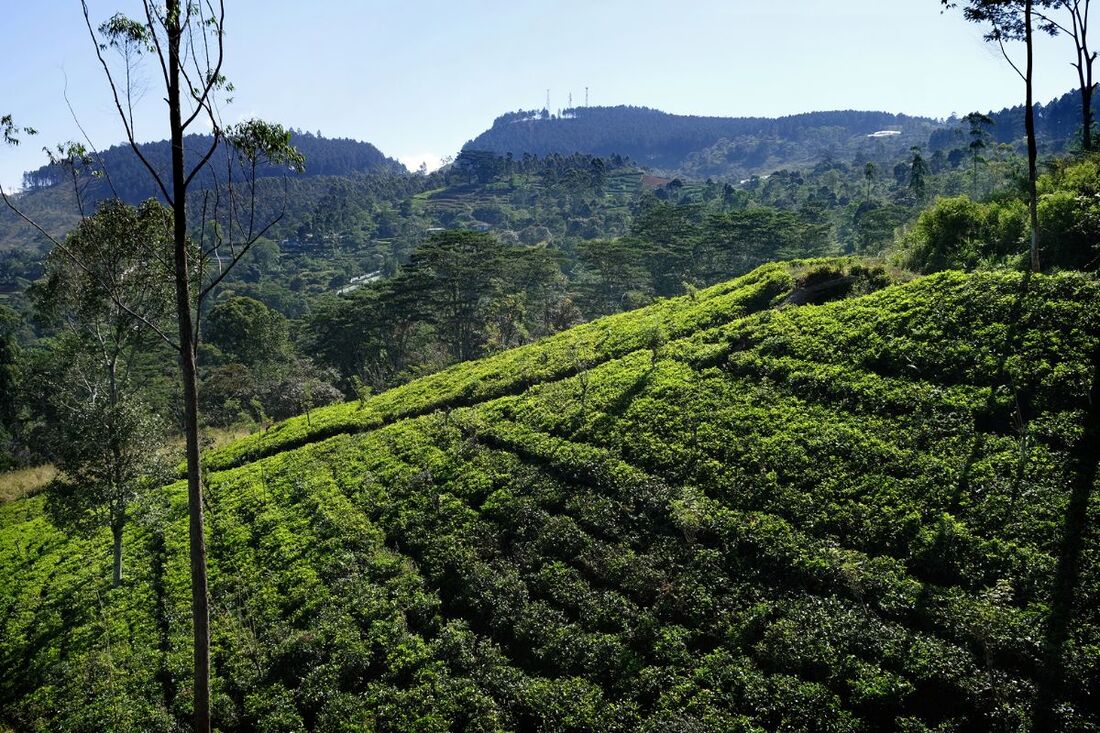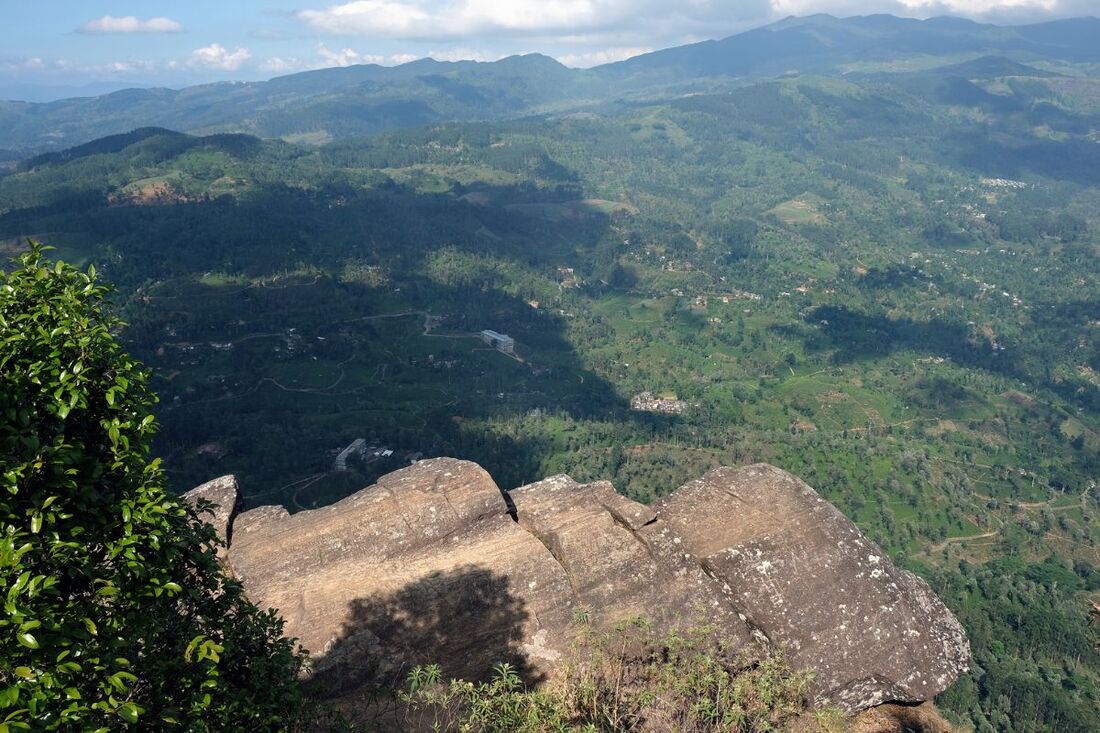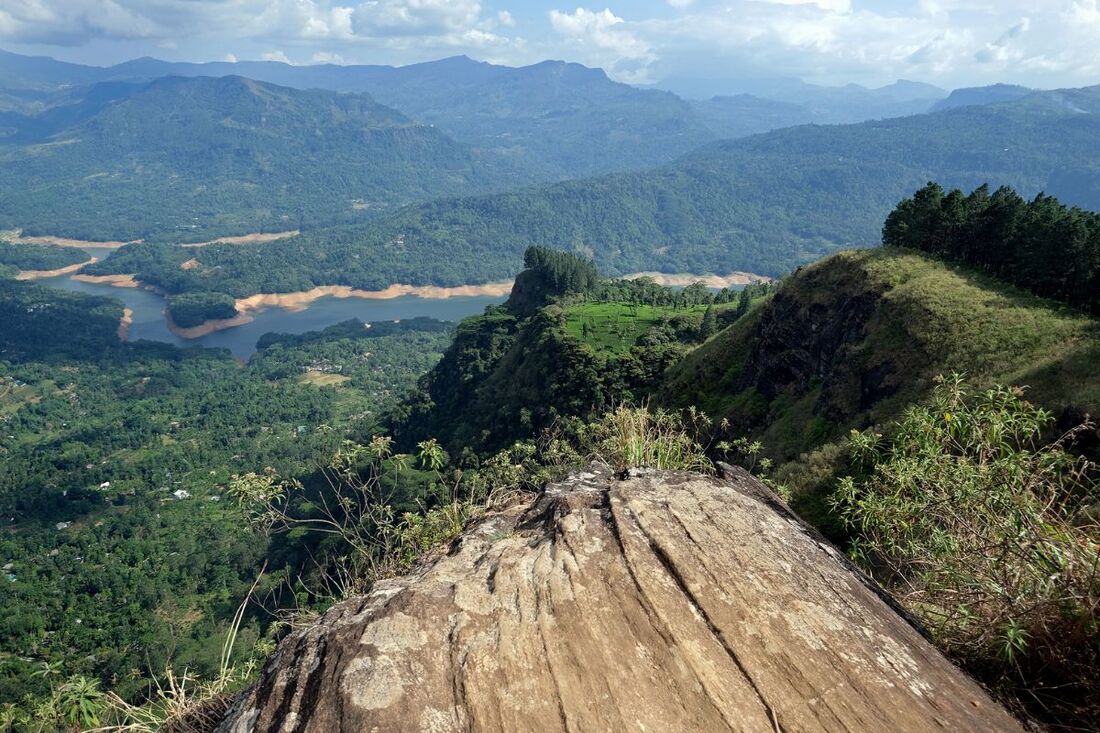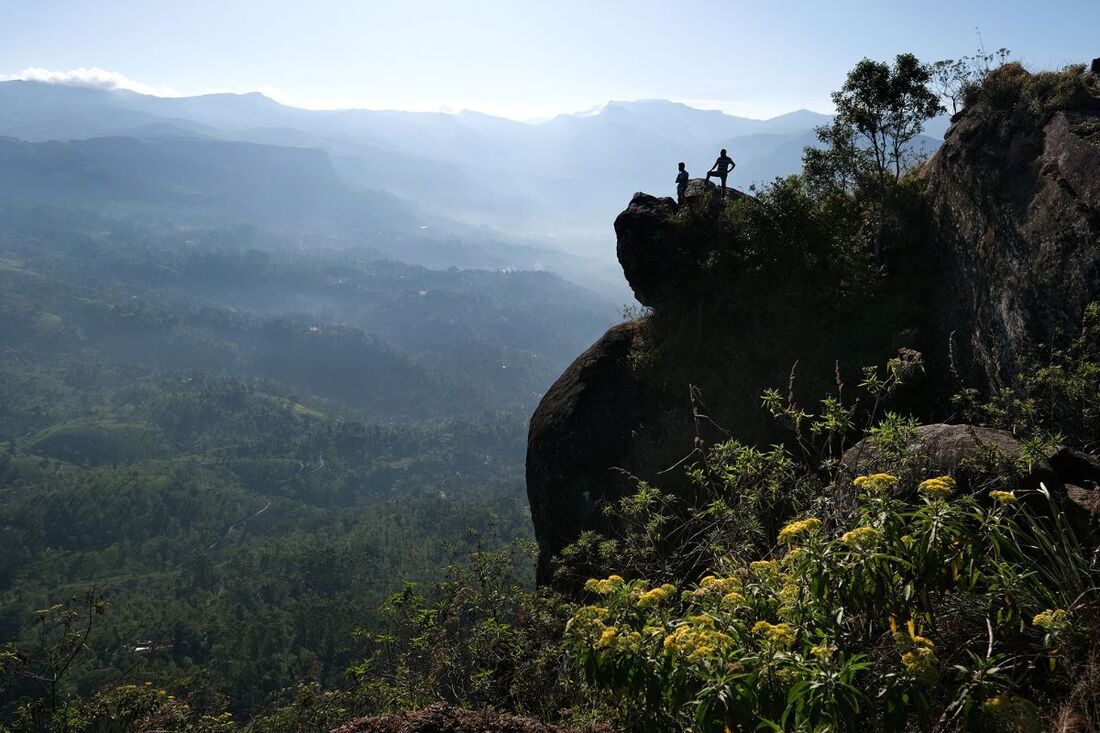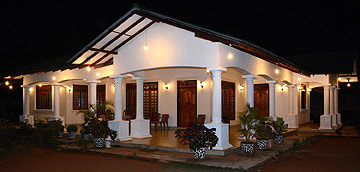Looking for a pretty short and easy hike to a spectacular summit with breathtaking cliffs and unforgettable panoramic views, not too far from the classic round tour route in Sri Lanka? Then consider a break of your journey in Pussellawa, halfway between Kandy and Nuwara Eliya, to take a tuctuc or jeep for a 15 km detour to the starting point of the short Peackock Hill Trail. The hike along a pretty pine forest path is only 1.5 km long and modestly steep. It takes only 20 to 30 minutes uphill.
From a distance, the Peackock Hill is easily recognizable by its three larger (plus one shorter) transmission towers. They are placed atop a vertical precipice, which towers Kotmale reservoir in the south. A steep cliff protruding from the main ridge looks like the head and neck and breast of a peacock, whereas a long forested "peacock tail" of a low gradient runs towards Gampola in the north.
From the top, you overlook the tea-growing area of Nuwara Eliya and the Kotmale reservoir just below the mountain. The framing background is formed by the highest and most central mountain range of Sri Lanka, which runs from Bhadravati near Galaha via Chariot Path to Pidurutalagala near Nuwara Eliya town.
From a distance, the Peackock Hill is easily recognizable by its three larger (plus one shorter) transmission towers. They are placed atop a vertical precipice, which towers Kotmale reservoir in the south. A steep cliff protruding from the main ridge looks like the head and neck and breast of a peacock, whereas a long forested "peacock tail" of a low gradient runs towards Gampola in the north.
From the top, you overlook the tea-growing area of Nuwara Eliya and the Kotmale reservoir just below the mountain. The framing background is formed by the highest and most central mountain range of Sri Lanka, which runs from Bhadravati near Galaha via Chariot Path to Pidurutalagala near Nuwara Eliya town.
Name of the Mountain
Referring to the shape of the mountain, the Sinhala name "Monaragala" has the very same meaning as "Peacock Hill" in English (or "Peacock Rocky-Hill", to be even more precise). The pronunciation sounds more like "Moneragale", stressed on the the third syllable ("ra"). The name "Monara Kanda", having almost the same meaning, is also used, but much less common than "Monaragala".
Don't confuse it with the town of Moneragala or the district of the same name in Uva Province in the southeast of the island. Monaragala of Pussallawa is neither the name of a town nor a district, but of the mountain and a tea growing area near in the Central Province.
Don't confuse it with the town of Moneragala or the district of the same name in Uva Province in the southeast of the island. Monaragala of Pussallawa is neither the name of a town nor a district, but of the mountain and a tea growing area near in the Central Province.
Location & how to get to the summit
Even more confusing than the similarity of the name Monaragala to that of a Sri Lankan town and district is the answer to the question, to which district the Peacock Hill alias Monaragala belongs? Pussallawa is a town in Kandy District. Administrationally, Nuwara Eliya District encompasses the neighbouring Kotmale Valley, but not Pussellawa. The boundary between these two districts of the Central Province runs just across the Peacock Hill. Most of the Monaragala range belongs to Kandy District, namely to the Udapalatha Divisional Secretariat, just like Pussalawa town. However, the summit is already within Nuwara Eliya District. Actually, the starting point of the 1.5 km long trail to the summit is still in Kandy District, whereas the summit is not. Luckily, your passports will not be checked at the official border of the two districts. But let's talk about geography:
|
Peacock Hill is the backyard mountain of Pussellawa, which is 40 km (25 miles) south of Kandy and equally 40 km north of Nuwara Eliya. The isolated Monaragala mountain, towering the Kotmale Valley, is clearly separated from the Central Highlands' main range by the Pussellawa Valley. Peacock Hill is the only mountain in the triangle formed by Gampola, Ramboda, and Nawalapitiya.
The Peacock Hill can be seen from many view points along the scenic mountain road A5, which is taken by almost all tourists traveling from Kandy via Ramboda to Nuwara Eliya. Travelling uphill from Gampola, you can see the Peacock Hill on the righthand side almost all the time along a 30 km long stretch of the road between Udapalatha and Labugolla. The latter, by the way, has the most scenic A5 view point, particularly near Highgrove Estate. This very best vantage point of the A5 mountain road is situated 3 km before the famous Damro Labookellie Tea Factory. Other nice views to the Monaragala Mountain are from Rothschild Tea Factory near Pussellawa and from Shri Bhakta Hanuman Temple in Tawalantenne. |
Peacock Hill alias Monaragala is just north of the Kotmale Reservoir.
|
Using a gravel track, the driving distance from the center of Pussellawa town to the starting point of the short Peacock Hill Trail is 14 km. The tea plantation dirt road runs along both the New Peackock Tea Factory and the Old Peacock Tea Factory. It's steep in some parts and very bumpy in long parts. But the route is pretty scenic. The lower parts of the gravel road offer lots of views to the triangular peaks of Kathusukonda and Uragala of Hanthana Range near Kandy and also to the closer-by Ambuluwawa Mountain towering Gampola and to the table mountain called Bible Rock (Batalagala) behind it. In the upper parts of the dirt road there are some glimpses of Dolosbage Mountain behind Nawalapitiya and, clear air for good visibility provided, even Adam's Peak (Siri Pada).
An alternative ascent route starts from Kotmale Dam on the opposite side of the mountain and first runs along the huge stupa dome of Kotmale Mahaweli Maha Seya and then further uphill, on a large segment of poor road condition, to Doragala Tea Factory. Soon afterwards, it meets the above mentioned direct route from Pussellawa. The two alternative ways to reach the trail start can be combined to a full circle, allowing to visit the summit of Monaragala and the various attractions at the Kotmale Lake and on a rewarding full-day round trip.
On the Summit of Peackock Hill
Though the summit of Monaragala alias Peacock Hill offers a tremendous scenery and reaching it requires no exhausting hikes, it's rarely visited by foreign travellers. However, it's well-known among locals. It can get a little bit crowded with visitors during weekends and holidays, particularly on weekends that are extended by Poya days.
The altitude of Monaragala alias Peacock Hill is 1513 m (4964 feet) above sea level. The height above the the nearby Kotmale Lake (with water levels changing) is around 700 m (2300 feet). When standing on the top, you have to be cautious, because there are almost vertical escarpments of up to 100 m (330 feet) in three directions and the first 300 meters (1000 feet) of the slopes facing Pusselawa and Kotmale Valleys have a gradient of 100%.
The altitude of Monaragala alias Peacock Hill is 1513 m (4964 feet) above sea level. The height above the the nearby Kotmale Lake (with water levels changing) is around 700 m (2300 feet). When standing on the top, you have to be cautious, because there are almost vertical escarpments of up to 100 m (330 feet) in three directions and the first 300 meters (1000 feet) of the slopes facing Pusselawa and Kotmale Valleys have a gradient of 100%.
The summit of Peacock Hill is the best vantage point for overlooking the entire main range of Sri Lanka's Central Highlands (forming the main watershed of the island) between Hanthana near Kandy and Pidurutalagala, Sri Lanka's highest peak, which is near Nuwara Eliya.
Below the forested summits, tea plantations cover the slopes of the mountains. From left to right, you can catch sights of the estates of New Peacock, Sogama, Rojah, Rothschild just below the cliff, Hellbodde (Glenloch), Frotoft, and Bluefield, all situated along the A5 mountain road, except from Frotoft, which is much further uphill.
Due to the proximity of the transmission towers, drones are strictly prohibited on the summit. When walking around, be aware that poisonous snakes inhabit also the rocky areas. Though sometimes used for wild camping, the summit has no officially recognized camp site.
Below the forested summits, tea plantations cover the slopes of the mountains. From left to right, you can catch sights of the estates of New Peacock, Sogama, Rojah, Rothschild just below the cliff, Hellbodde (Glenloch), Frotoft, and Bluefield, all situated along the A5 mountain road, except from Frotoft, which is much further uphill.
Due to the proximity of the transmission towers, drones are strictly prohibited on the summit. When walking around, be aware that poisonous snakes inhabit also the rocky areas. Though sometimes used for wild camping, the summit has no officially recognized camp site.
Best time to visit the Peacock Hill
|
For photographers, only the afternoon light is from the back. However, morning hours usually offer clearer views, and the frontlighting might also be appealing, see the sample contre-jour shot (just to the right here).
March has the most sunshine hours in this region. Best chances to enjoy good views are between October and April. Though November and December have the highest rainfall, the lowest precipitation in the area of Pussellawa and Kotmale Valley is June and July. The coolest temperatures on Peacock Hill are in January and highest around May. |
A Historical Episode attributed to MonAragala
Local folklore has it that Prince Dutugemunu, when he had to flee from the wrath of his father, came from Magama (Tissamaharama) and farmed in a village called Kotagepitiya in Kotmale Valley just below the Peacock Hill for many years. Legend has it that he used to take his poultry to Peacock Hill and received messages transmitted by the giant Suranimala through the rock of the mountain.
